
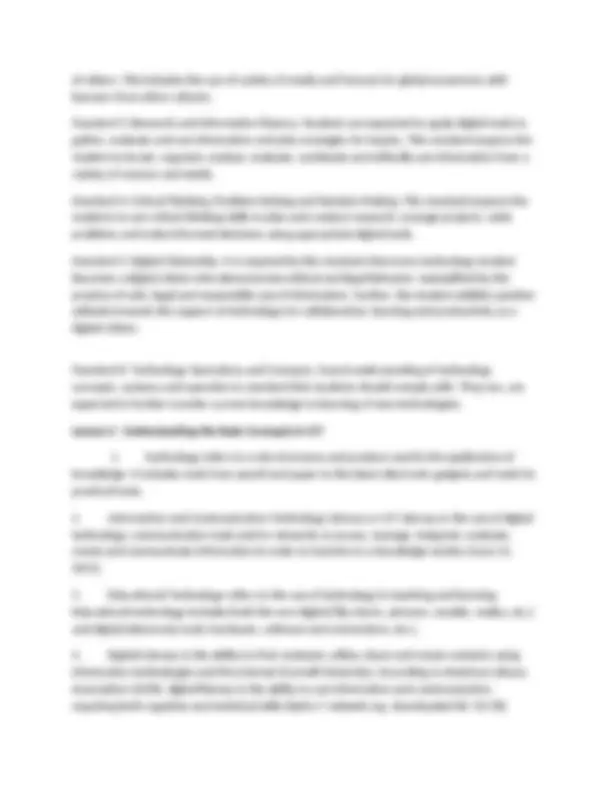
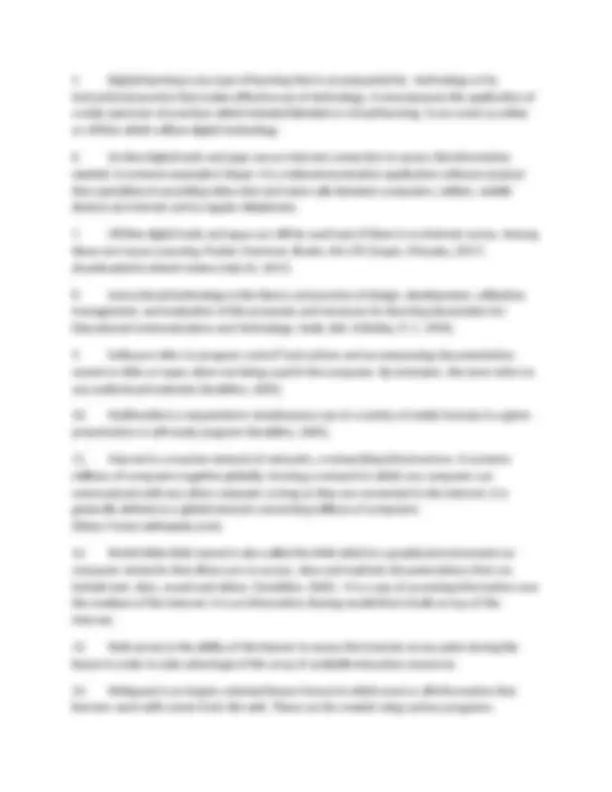
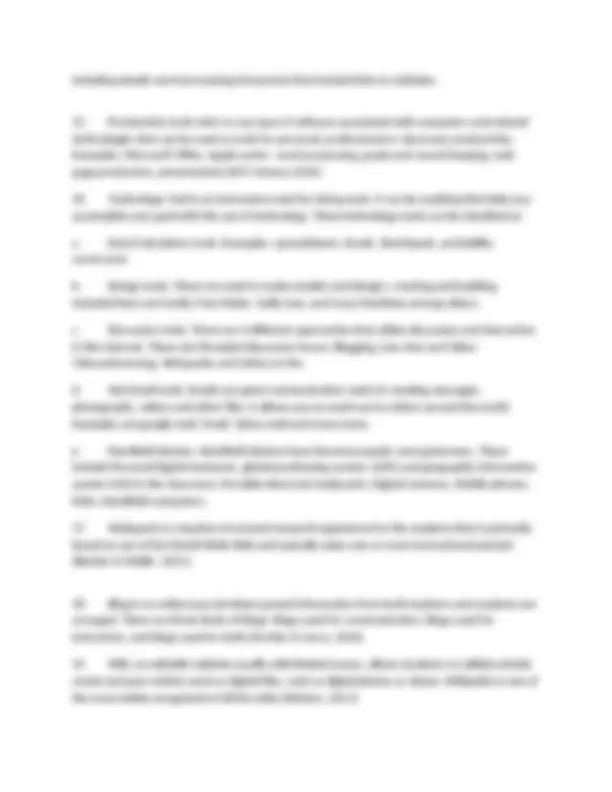
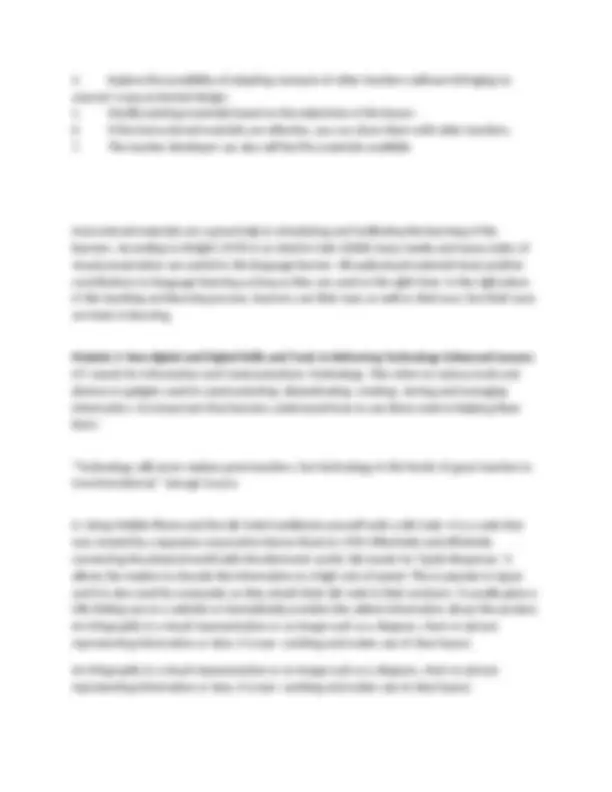
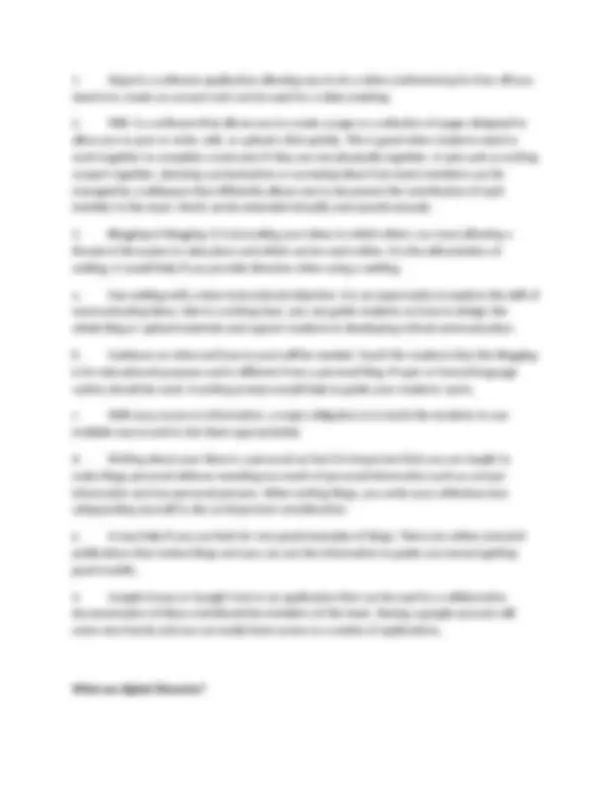
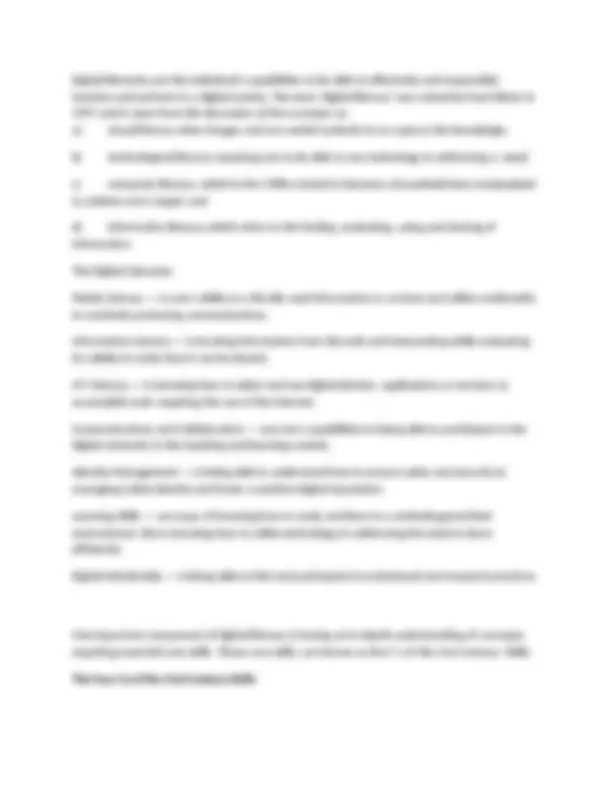



Study with the several resources on Docsity

Earn points by helping other students or get them with a premium plan


Prepare for your exams
Study with the several resources on Docsity

Earn points to download
Earn points by helping other students or get them with a premium plan
Community
Ask the community for help and clear up your study doubts
Discover the best universities in your country according to Docsity users
Free resources
Download our free guides on studying techniques, anxiety management strategies, and thesis advice from Docsity tutors
This comprises the summary of lessons from module 1-3 of technology for Teaching subject
Typology: Study Guides, Projects, Research
1 / 13

This page cannot be seen from the preview
Don't miss anything!








Module 1: Technology for Teaching and Learning: An Introduction ICT Competency Standards (CHED-UNESCO) as provided in the 2017, Policy, Standards and Guidelines (PSG) for Pre-service Teacher Education The program outcomes for teacher education degrees clearly state that every future teacher: "demonstrate proficiency in the development and utilization of Information, Communication and Technology (ICT) resources in promoting quality teaching-learning process." To ensure that the program outcomes related to ICT shall be achieved, competencies were identified to be developed by every pre-service teacher (CUED — UNESCO, Bangkok, 2009.) The ICT Competency Standards is made up of seven domains. Each domain has set of competencies. The competencies are expressed in desired learning outcomes. Becoming proficient in the different competencies will enable you to handle learners the 21st century in your future classroom Domain 1: Understanding ICT in Education Domain 2: Curriculum and Assessment Domain 3: Pedagogy Domain 4: Technology Tools Domain 5: Organization and Administration Domain 6: Teacher Professional Learning Domain 7: Teacher Disposition Likewise, the Department of Education issued Department of Education Order 42, s. 2017 mandating the use of the Philippine Professional Standard for Teachers (PPST) to start with the Beginning Teachers who are the fresh graduates from the teacher education program. The document includes: Show skills in the positive use of ICT to facilitate teaching and learning and Show skills in the selection, development and use of the variety of teaching learning resources including ICT to address learning goals. ISTE National Educational Technology Standards For TEACHERS (NETS* T) An international organization for educational technology called International Society for Technology in Education (ISTE), established standards for both teachers and students. These standards were also referred to in the development of the Philippine ICT Competency standards which include the following:
Standard 1: Technology Operations and Concepts. This means that teachers demonstrate a sound understanding of technology operations and concepts. Standard 2: Planning and Designing Learning Environment and Experiences. This standard implies that teachers utilize the use of technology to plan and design effective learning environments and experiences. Standard 3: Teaching, Learning and Curriculum. Teachers should be mindful that in the implementation of curriculum plan, they have to include strategies for applying technology to maximize student learning. Standard 4: Assessment and Evaluation. Teachers apply technology to facilitate a variety of effective assessment and evaluation strategies to collect and analyze data, interpret results, and communicate findings to improve instructional practice and maximize student learning. Standard 5: Productivity and Professional Practice. Teachers use technology to engage in on- going professional development and lifelong learning in support of student learning, increase productivity and to build community of learners. Standard 6: Social, Ethical, Legal and Human Issues. Teachers understand the social, ethical, legal and human issues surrounding the use of technology in support of student learning who come from diverse background, affirm diversity, promote safe and healthy use of technology resources and facilitate access to technology resources for all students. Likewise, ISTE also developed standards needed for students. These standards will be used as a guide by teachers to plan technology-based activities in which students achieve success in learning, communication and life skills. ISTE National Educational Technology Standards For STUDENTS (NETS* S) From how technology teachers facilitate learners, outcomes of student learning should indicate that the following standards have been complied with. Standard 1: Creativity and Innovation. This standard will produce students who demonstrate creative thinking, construct knowledge, develop innovative products and processes using technology from existing knowledge. Standard 2: Communication and Collaboration. This standard requires students to use digital media and environments to communicate and work collaboratively to support individual learning and contribute to the learning
including simple word processing documents that include links to websites.
communications and other forms of communications are still in their infancy. In addition to Internet, this category also includes mobile telephone, cable, DSL, satellite and other broadband connectivity. The ICT for Education (ICT4E) is a program under the DICT that support all the efforts of the education sector in incorporating the use of ICTIssue No. 1: Freedom of Expression and Censorship Issue No. 2: Privacy and Security Issue No. 3: Surveillance and Data Retention Dataveillance is the of personal information to monitor a person's activities while data retention is storage and use of information from communication systems. Issue No. 4: E- pollutants from E-waste Module 3: Non-digital and Digital Skills and Tools in Delivering Technology-Enhanced Lessons Instructional materials are defined as print and non-print items that are rested to impact information to students in the educational process (Effiong & Igiri, 2015). Examples of instructional materials are drawings, kits, textbooks, posters, magazines, flip chart, newspapers, diorama, pictures, recording videos and the like. Instructional materials have several roles in teaching and learning which include the following: (1) they promote meaningful communication and effective learning; (2) they ensure better retention, thus making learning more permanent; (3) they help to overcome the limited classroom by making the inaccessible accessible; (4) they a common experience upon which late learning can be developed; and (5) they encourage participation especially if students are allowed to manipulate materials used (Brown et al., 2005; Effiong & Igiri, 2015). Instructional materials are the supplementary materials, which help the teacher to make his/her presentation concrete, effective, interesting, meaningful and inspiring In any teaching and learning process, instructional materials play a vital role as they provide sensory experiences to the learners. The primary aim of teaching material is to provide the teachers the layout of the way for teaching in the classroom. It is important to understand how to develop instructional materials. Instructional materials refer to any preexisting materials that are being incorporated, as well as those that will be specifically developed for the objectives (Haigler, 2014). There are also several factors to consider in developing instructional materials:
Digital literacies are the individual's capabilities to be able to effectively and responsibly function and perform in a digital society. The term 'digital literacy' was coined by Paul Gilster in 1997 and it came from the discussion of the concepts on a) visual literacy when images and non-verbal symbols try to capture the knowledge; b) technological literacy requiring one to be able to use technology in addressing a need; c) computer literacy, which in the 1980s started to become a household item manipulated to achieve one's target; and d) information literacy which refers to the finding, evaluating, using and sharing of information. The Digital Literacies Media Literacy — is one's ability to critically read information or content and utilize multimedia in creatively producing communications. Information Literacy — is locating information from the web and interpreting while evaluating its validity in order that it can be shared. ICT Literacy — is knowing how to select and use digital devices, applications or services to accomplish tasks requiring the use of the internet. Communications and Collaboration — are one's capabilities in being able to participate in the digital networks in the teaching and learning context. Identity Management — is being able to understand how to ensure safety and security in managing online identity and foster a positive digital reputation. Learning Skills — are ways of knowing how to study and learn in a technologyenriched environment; this is knowing how to utilize technology in addressing the need to learn efficiently. Digital Scholarship — is being able to link and participate in professional and research practices. One important component of digital literacy is having an in-depth understanding of concepts requiring essential core skills. These core skills. are known as the C’s of the 21st Century- Skills. The Four Cs of the 21st Century Skills
The four C's of the 21st Century Skills refer to critical thinking, creativity, communication, and collaboration. To perform well in this century, you need to develop and enhance these skills namely creativity, critical thinking, communication and collaboration. All of these 21st century skills are essentials for students to do well in school and succeed in the workplace.
communicate information requiring both cognitive and technical skills. are examples of how Digital Skills or Proficiency support Digital Literacy.